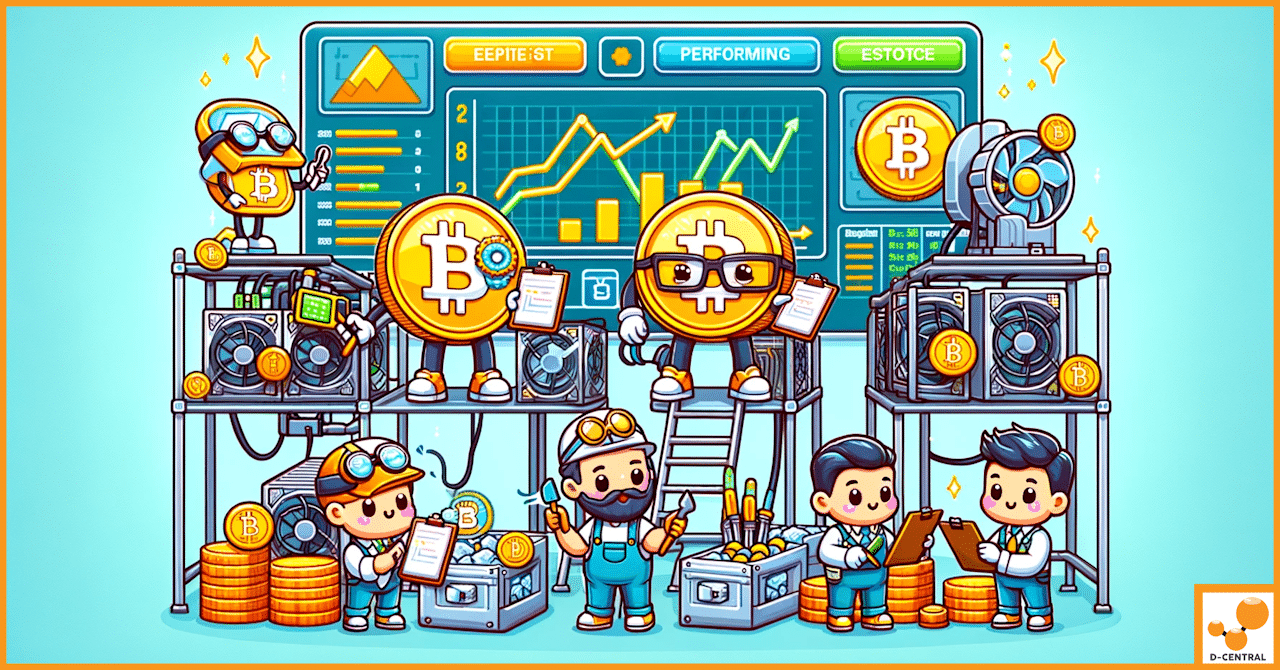
Home Bitcoin Mining and Energy Arbitrage: Capitalizing on Price Fluctuations
Dive into the world of home Bitcoin mining and discover how energy arbitrage can maximize your profits. Learn about D-Central’s
4479 Desserte Nord Autoroute 440, Laval, QC H7P 6E2

Bitcoin mining stands as a cornerstone in the edifice of the cryptocurrency world, embodying both the pioneering spirit and the innovative technology that drive this digital revolution. At its core, Bitcoin mining is the process by which new bitcoins are introduced into circulation, but it is also critical for maintaining and developing the blockchain ledger. Through the computational labor of mining, miners solve complex mathematical puzzles, thereby securing the network against fraudulent transactions and ensuring the integrity of the entire Bitcoin ecosystem.
The significance of Bitcoin mining extends beyond the mere creation of new coins. It represents a decentralized consensus mechanism that eliminates the need for traditional intermediaries, such as banks and governments, in financial transactions. This not only challenges the conventional monetary system but also offers a new paradigm of trust and transparency in digital transactions.
However, the competitive nature of mining, combined with the finite supply of Bitcoin, has led to an ever-increasing demand for computational power. As a result, the quest for efficiency in mining operations has become paramount. Efficiency, in this context, is not merely about maximizing output but achieving a harmonious balance between energy consumption, computational power, and environmental sustainability. The profitability of mining ventures hinges on the ability to optimize these factors, as the rewards of mining must outweigh the costs associated with electricity and hardware investment.
Moreover, as the Bitcoin network grows and the difficulty of mining increases, the importance of efficiency becomes even more pronounced. Sustainable mining practices are not just beneficial for individual miners but are essential for the long-term viability of the Bitcoin network as a whole. It is through the lens of efficiency that miners can navigate the challenges of resource consumption and environmental impact, ensuring that Bitcoin mining remains a profitable and sustainable endeavor in the cryptocurrency landscape.
In essence, the drive for efficiency in Bitcoin mining encapsulates the broader challenges and opportunities presented by the digital age: balancing innovation with sustainability, competition with collaboration, and individual gain with collective good.
Bitcoin mining is the backbone of the Bitcoin network, serving a dual purpose: it introduces new bitcoins into circulation and secures the network by verifying transactions. This process involves miners competing to solve complex mathematical puzzles using computational power. The first miner to solve the puzzle gets the opportunity to add a new block of transactions to the blockchain, the decentralized ledger that records all Bitcoin transactions. In return for their efforts and the resources expended, miners are rewarded with newly minted bitcoins and transaction fees.
Mining is inherently a proof of work (PoW) system, a mechanism designed to deter cyber-attacks such as distributed denial-of-service (DDoS) attacks, which can overwhelm the system with information. To mine successfully, miners must invest in powerful computer hardware capable of performing trillions of calculations per second. The difficulty of these puzzles adjusts automatically to ensure that a new block is added to the blockchain approximately every 10 minutes, regardless of the total computational power of the network.
The Proof of Work (PoW) consensus mechanism is a critical element that ensures the security and integrity of the blockchain. PoW requires a participant in the network to expend effort (work) to solve an arbitrary mathematical puzzle. The complexity of this puzzle is adjustable and is set so that the network collectively solves a puzzle at a consistent rate, irrespective of the total computational power.
This mechanism prevents malicious actors from altering the blockchain, as they would need to outcompete the honest miners in computational power, which would be prohibitively expensive due to the energy and hardware costs involved. PoW also facilitates consensus across the decentralized network, ensuring that all participants agree on the validity of transactions without needing a central authority.
Miners play a pivotal role in the Bitcoin network beyond just creating new bitcoins. They are the custodians of the network’s security and integrity, verifying the legitimacy of transactions and ensuring that no double-spending occurs. Each time miners add a new block to the blockchain, they reinforce the security of previous transactions, making it exponentially more difficult to alter historical data.
Moreover, miners contribute to the decentralization of the Bitcoin network. By distributing the computational power across a global network of miners, Bitcoin remains resistant to censorship and immune to control by any single entity. This decentralization is a key feature that makes Bitcoin a truly open and democratic form of digital currency.
In summary, Bitcoin mining is not just a process of generating new bitcoins but a critical function that secures, validates, and decentralizes the network. Through the Proof of Work consensus mechanism, miners ensure the reliability and integrity of the Bitcoin blockchain, making it a robust and trustless system for peer-to-peer transactions.
In the realm of Bitcoin mining, the choice of hardware is pivotal to the operation’s success. The three primary types of mining hardware are Application-Specific Integrated Circuits (ASICs), Graphics Processing Units (GPUs), and Central Processing Units (CPUs).
The choice between ASICs and GPUs for Bitcoin mining boils down to efficiency vs. flexibility.
When venturing into Bitcoin mining, several key factors must be considered to ensure the profitability and sustainability of your mining operation:
Selecting the right mining hardware is a critical decision that can determine the success of your Bitcoin mining endeavor. By carefully considering the hash rate, power consumption, and cost of ASICs, GPUs, and CPUs, miners can choose the hardware best suited to their goals, budget, and the specific requirements of their mining operation.
Optimizing mining hardware is crucial for maximizing the efficiency and profitability of your mining operation. Properly tuned hardware can significantly increase hash rates while minimizing power consumption, directly impacting the bottom line. Optimization ensures that you are not merely running your equipment but are running it at its most effective state, squeezing out every bit of performance without unnecessarily wasting resources.
While optimizing your mining hardware for peak performance is desirable, it’s essential to strike a balance between achieving high hash rates and ensuring the longevity of your equipment. Overclocking and undervolting, if not done correctly, can stress your hardware and lead to premature failure.
Optimizing mining hardware settings is a delicate art that requires a careful approach. By understanding and respecting the limits of your equipment, and by continuously monitoring and adjusting your settings, you can achieve an optimal balance between performance, power efficiency, and hardware longevity. This balance is key to maintaining a profitable and sustainable mining operation over the long term.
The quest for energy efficiency in Bitcoin mining is not just about environmental stewardship; it’s a critical component of operational profitability. As electricity costs can consume a significant portion of mining revenue, adopting strategies to minimize power usage is essential.
Incorporating renewable energy sources into mining operations isn’t just a sustainability practice; it’s becoming a cornerstone strategy for enhancing profitability.
By leveraging renewable energy sources and optimizing hardware for energy efficiency, miners can significantly reduce their operational costs and increase profitability. As the global focus on sustainability intensifies, the adoption of green energy solutions in mining operations is not just an ethical choice but a strategic economic decision.
The choice of mining software is crucial for anyone looking to venture into Bitcoin mining. It acts as the bridge between the mining hardware and the Bitcoin network. Here are some of the most popular Bitcoin mining software options:
Optimizing your mining software involves adjusting settings to balance performance, power consumption, and hardware longevity. Here are some tips for configuring your mining software:
Joining a mining pool can significantly increase your chances of earning Bitcoin. Mining pools combine the computational power of multiple miners, increasing the likelihood of solving a block and earning rewards, which are then shared among pool members based on their contributed hash power.
By carefully selecting your mining software and configuring it for optimal performance, you can maximize your mining efficiency. Joining the right mining pool further enhances your chances of success in the competitive world of Bitcoin mining, making it a critical decision for any miner.
Heat generation is an inevitable byproduct of cryptocurrency mining, given the intensive computational work performed by mining hardware. As miners push their equipment to maximize hash rates, the generated heat can significantly increase, leading to potential hardware damage, reduced efficiency, and increased operational costs. Managing this heat is crucial to maintaining a sustainable and profitable mining operation.
Effective heat management is critical for the longevity and profitability of mining operations. By employing a combination of traditional and innovative cooling solutions, miners can protect their hardware investment, improve operational efficiency, and maintain a competitive edge in the ever-evolving landscape of cryptocurrency mining.
Mining profitability is the linchpin of a successful Bitcoin mining operation. It hinges on a delicate balance between potential earnings and operational expenses. To gauge profitability, miners must consider several factors:
A comprehensive understanding of both earnings and expenses is crucial for miners to assess the viability of their mining operations and make informed decisions about scaling up or optimizing their setups.
Bitcoin’s price volatility directly impacts mining profitability. When prices soar, the potential earnings from mining can increase dramatically, making previously marginal operations profitable. Conversely, price dips can reduce the value of rewards, squeezing the profit margins of miners, especially those with higher operational costs.
Miners must stay attuned to market trends and be prepared to adjust their strategies in response to price fluctuations. This might involve scaling operations up or down or shifting focus to more cost-effective mining practices during periods of lower prices.
Bitcoin mining is subject to two critical long-term considerations: halving events and the increasing difficulty of mining.
To navigate these challenges, miners should focus on efficiency and flexibility. Investing in the most efficient mining hardware available and being prepared to switch between different cryptocurrencies or mining pools based on profitability are strategies that can help miners remain competitive. Additionally, diversifying income sources, such as participating in staking or yield farming with the earnings from mining, can provide a buffer against the inherent volatility and long-term uncertainties of Bitcoin mining.
The economics of Bitcoin mining require a strategic approach that balances immediate profitability with long-term sustainability. Understanding the interplay between earnings, expenses, market dynamics, and network changes is crucial for anyone looking to succeed in the competitive world of cryptocurrency mining.
Cloud mining presents a compelling alternative for individuals and small-scale miners looking to participate in Bitcoin mining without the hefty investment in hardware and infrastructure. This model allows users to rent mining power hosted in remote data centers, eliminating the need for physical hardware on the miner’s premises. The key advantages include:
However, potential cloud miners should conduct thorough research to avoid scams and ensure they are dealing with reputable providers. Understanding the contract terms, payout mechanisms, and potential returns is crucial before committing to a cloud mining service.
Artificial Intelligence (AI) and Machine Learning (ML) are poised to revolutionize Bitcoin mining by optimizing various aspects of the mining process for enhanced efficiency and profitability. Potential applications include:
As these technologies continue to evolve, their integration into mining operations could significantly reduce operational costs and increase the profitability of Bitcoin mining.
The future of Bitcoin mining technology promises further advancements in hardware efficiency, energy sourcing, and operational optimization. Key trends to watch include:
As Bitcoin continues to mature, mining operations will likely become more sophisticated, leveraging cutting-edge technology to improve efficiency and reduce environmental impact. The miners who stay ahead of these trends and adapt their strategies accordingly will be best positioned to thrive in the evolving landscape of cryptocurrency mining.
In the competitive and lucrative world of Bitcoin mining, security is paramount. A breach can lead to significant financial loss, operational downtime, and damage to reputation. Here are essential security best practices every miner should implement:
To ensure your mining operation runs smoothly and efficiently, regular maintenance and monitoring are crucial. This involves:
The Bitcoin mining landscape is constantly evolving, with new technologies, strategies, and challenges emerging regularly. Staying informed is key to maintaining a competitive edge:
Maintaining a secure and efficient mining operation requires a proactive approach to security, regular maintenance and monitoring, and a commitment to continuous learning and adaptation. By implementing these practices, miners can protect their assets, optimize their operations, and position themselves for long-term success in the dynamic world of cryptocurrency mining.
In the intricate world of Bitcoin mining, efficiency and security stand as the pillars upon which successful operations are built. From selecting the right hardware to optimizing mining software, and from implementing robust security measures to conducting regular maintenance, each aspect plays a crucial role in maximizing profitability and ensuring the longevity of mining endeavors.
The journey through the essentials of mining hardware has highlighted the importance of choosing between ASICs, GPUs, and CPUs based on specific needs and goals. We’ve explored the delicate art of balancing performance with hardware longevity through overclocking and undervolting, and underscored the critical role of energy efficiency in reducing operational costs. The exploration of advanced strategies, including cloud mining and the potential of AI and machine learning, opens new avenues for enhancing mining operations.
As Bitcoin mining continues to evolve, driven by technological advancements and shifts in the cryptocurrency landscape, the emphasis on efficiency has never been more paramount. The advent of new mining technologies and the increasing difficulty of mining algorithms demand that miners remain agile, constantly seeking ways to improve and innovate.
To those embarking on or continuing their mining journey, the invitation stands to dive deeper into the vast reservoir of knowledge that the Bitcoin mining community offers. Engage with forums such as Bitcointalk and Reddit, participate in communities on platforms like Discord and Telegram, and leverage educational resources from websites like CoinDesk and the Bitcoin Wiki. These platforms not only provide valuable information but also foster collaboration and shared learning among miners worldwide.
In conclusion, the path to successful Bitcoin mining is paved with challenges, but it also offers immense rewards for those willing to navigate its complexities. By staying informed, embracing innovation, and prioritizing efficiency and security, miners can not only thrive in the current landscape but also shape the future of cryptocurrency mining. Let this be a call to action: to continuously seek improvements, share insights, and contribute to the collective knowledge and advancement of the Bitcoin mining community.
What is Bitcoin mining?
Bitcoin mining is the process by which new bitcoins are introduced into circulation and involves verifying and adding transaction records to Bitcoin’s public ledger (blockchain).
What is the significance of Bitcoin mining?
Bitcoin mining is crucial for maintaining the blockchain ledger, securing the network against fraudulent transactions, acting as a decentralized consensus mechanism, and challenging traditional financial systems with a new paradigm of trust and transparency in digital transactions.
What is the Proof of Work (PoW) consensus mechanism?
The PoW consensus mechanism requires miners to expend computational effort to solve mathematical puzzles, ensuring network security and facilitating consensus without the need for a central authority.
What roles do miners play in the Bitcoin network?
Miners introduce new bitcoins into circulation, ensure network security by verifying transactions, prevent double-spending, and help maintain the decentralization of the network.
What are the primary types of Bitcoin mining hardware?
The main types of mining hardware are Application-Specific Integrated Circuits (ASICs), Graphics Processing Units (GPUs), and Central Processing Units (CPUs).
How does the choice between ASICs and GPUs affect Bitcoin mining?
ASICs offer unmatched efficiency and speed for Bitcoin mining but lack flexibility, while GPUs offer a balance between performance and flexibility, allowing miners to mine different cryptocurrencies.
What are the key factors to consider when selecting mining hardware?
When selecting mining hardware, miners should consider hash rate, power consumption, and hardware costs to ensure profitability and sustainability of the mining operation.
What are some strategies for optimizing mining hardware settings?
Optimizing mining hardware involves overclocking for increased performance and undervolting for reduced power consumption, balancing performance with hardware longevity.
How important is energy efficiency in Bitcoin mining?
Energy efficiency is critical in Bitcoin mining for reducing operational costs, optimizing profitability, and minimizing environmental impact.
What role does renewable energy play in Bitcoin mining?
Renewable energy sources, such as solar, wind, and hydropower, are increasingly used in mining operations to reduce environmental impact and operational costs, enhancing profitability.
DISCLAIMER: D-Central Technologies and its associated content, including this blog, do not serve as financial advisors or official investment advisors. The insights and opinions shared here or by any guests featured in our content are provided purely for informational and educational purposes. Such communications should not be interpreted as financial, investment, legal, tax, or any form of specific advice. We are committed to advancing the knowledge and understanding of Bitcoin and its potential impact on society. However, we urge our community to proceed with caution and informed judgment in all related endeavors.
Related Posts

Dive into the world of home Bitcoin mining and discover how energy arbitrage can maximize your profits. Learn about D-Central’s

In the fast-paced world of cryptocurrency mining, maintaining the peak performance of your mining rigs is not just beneficial—it’s essential.

In recent times, the environmental impact of Bitcoin mining has come under intense scrutiny, with a specific focus on its